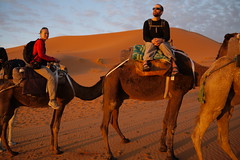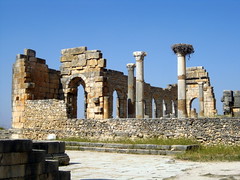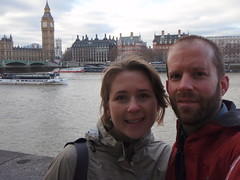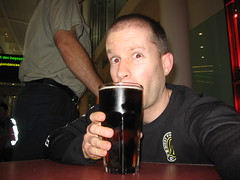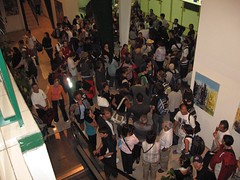Welcome back to another, and perhaps my final post on our adventures in Morocco. My apologies for the slight delay between posts. I was off to Toronto for a conference, and had other family obligations. At any rate, on the plus side, we now have all of our pictures put up on flickr. I’ve even added a folder of videos as well, with a few clips that I shot in various places. For this post, I’m going to take you on two unique journeys. The first will be a camelback ride out into the dunes of the Erg Chebbi, where we spent the night in a Berber camp. The second part of the story will be our exploration of the ancient Roman ruins of Volubilis, an expansive site which was one of the farthest trading posts of the Roman empire. Both of these little adventures was pretty amazing, and this was the first time that either of us had ventured by camel into a desert, and spend the night under the stars in the desert. Once you’ve had chance to peruse the desert pictures and Roman ruin pictures, hop on back and read the whole tale.
Our camel journey started in the far southeast of the country. We set out from a little town called Merzouga. If you look at a map, you’ll see that it is situated very close to the Algerian border, which is actually closed, and there are rather severe consequences if you were to cross it. Suffice to say, we didn’t cross it. The long dusty road trip to Merzouga took us through a number of other little Moroccan towns, in one of which we bought some pretty cool black marble candleholders with fossils in them. We didn’t actually get to Merzouga until near the end of the day, which was the plan, as it meant we’d be making our camel trek through the sunset and dusk. On arrival to the little outpost, we immediately saw a long string of camels laying disinterestedly in the sand, their legs tied so they couldn’t wander off.
There were 6 of us in total in our group. Deanna and I, the two Scottish ladies we’d climbed in the Atlas with, and a young Swiss couple that arrived by car. After buying some water to last us till the next day, and a quick mint tea (of course) we were led to our camels. The Berber guide chose a camel for each of us. I was given a camel that was already laden with some gear. Apparently, they figured I weighed less, and would therefore be easier on my camel. We were up and heading out in no time flat.
I will tel you this right now. Camels are NOT what you’d call a ‘graceful’ animal. They move awkwardly, and make a myriad of strange noises (owing to their constant digestion), and also source some rather interesting odours, not unlike rotting eggs at times. While they may look rather cute and aloof from a distance, they are a very interesting beast up close. Also, straddling one of these wide beasts, on a steel framed ‘saddle’ of sorts, isn’t that comfy either. Owing to that, it didn’t take long before half of us had chosen to ride our camels in some sort of side saddle style.
The ride itself was pretty unique. Our Berber guide (who was on foot and guiding our ‘camel train’) led us up and down and all around a series of small dunes. We wandered for almost 90 minutes in the fading light until we came to our camp for the night. We’d passed by a few other desert wanderers on our way. By the time we arrived at camp, the light was pretty much all gone, but not so much that I didn’t notice that where we dismounted was a minefield of camel dung, which presents itself as slighly larger than walnut-sized pellets, not unlike chocolate easter eggs. It was everywhere! Obviously they bring groups every night in varying numbers. There were already a couple other tourists there who would be camping, but it was otherwise pretty quiet. That is, until the next ‘camel train’ arrived, laden with a group of about 20 Europeans, all of whom seemed to be smokers. Ugh. So much for a peaceful night in the desert.
Luckily, nothing prevented me from leaving camp armed with my camera and wandering away on my own for a bit. The desert is a pretty surreal environment. It’s rather disorienting to be surrounded by a sea of sand. After we all had a big meal, the youngest Berber invited us to join him in a trek up the highest nearby dunes. Perfect! We set out, and it was immediately clear he intended to be the first and to shame the tourists with his skill. Not his day though, as ActiveSteve kept up step by step the whole way up. The two of us eventually lost everyone far below us. We summitted the first big dune, and then he pointed to another one that we also scaled. Here, at this highest point, we finally stopped to wait for the rest. Surprisingly, it would be fully 30 minutes before the main group caught up. By then, we’d had a nice chat, and I had decided to head back down with Deanna, who had also pushed hard to secure 3rd overall (not that it was a contest).
The height of the dunes was quite misleading. Once at the top of the big dune, it was clear just how tiny all the other were below us. However, in the camp, the high dune really didn’t seem all that tall. Of course, this just begs the question now, doesn’t it? Will I ever choose to tackle the Marathon des Sables? Given that they run during the daytime highs, I’m guessing no, but who knows?
The next morning, we got up before sunrise to re-mount our camel friends, and ride off into the dunes to experience the sunrise in the desert. It was a pretty great morning. We’d been lucky with good temperatures and virtually no wind. Back at our starting point from the day before, we had a quick breakfast, and everyone went their own ways. For us, that was back to Marrakech. It was the end of a great adventure for us.
So, now, how about those deserted ruins you ask? Well, this was at a site known as Volubilis. This is yet another UNESCO World Heritage site that has undergone significant restoration. This was a significant trading post, whose main exports included grain and of course olive oil. Indeed, during the 5km walk to and from the ruins that Deanna and I made from Moulay Idriss (where we were staying), we wandered through many an olive grove. As with most of our trip, the weather was once again spectacular. Hot sun beat down on us as we wandered to the entry gate to pay our small admission fee which worked out to less than 2 dollars. There were very few tourists on our arrival, so we had the vast ruins to ourselves. Well, us and the many guides touting their services near the entryway. We passed on the pricey service, opting instead to use our 2 guidebooks, which between them had maps and lots of explanations of the area. That way, we weren’t limited to just a 1 hour tour, but could take our time and poke and prod all over on our own.
Exploration was the name of the game here. We started at one end of the site and very gradually made our way under the hot sun to all corners of the ruins. What looked like a fairly compact site froma distance soon revealed itself to be a fairly large area. Much of it is still under thick vegetation, and we figured they will spend several more years unearthing more treasures in the area. I’ve been to other small Roman ruins in other travels, but nothing like this. We were truly able to get a sense of the kind of village life that these Romans may have lived. We wandered through the residential quarters of the workaday people, meandering over to the city center, with the Forum, the Arcade, the baths, the arch, etc. Finally, turning right, you are lead up the grand boulevard where the rich folk and administrators lived.
This rich area is where you see a lot more of the details and features that make these ruins a real standout. There are mosaics in these areas are well over 2000 years old, yet still retain some of their vivid colours. It is truly remarkable to imagine just how old these mosaics and ruins are. The craftsmenship and ingenuity displayed is remarkable. Possibly one of my faviourite little details though was a manhole cover that was there. As with today’s, it was round, and had a few slots on it. However, it was of course made of stone, and has been walked on for many many centuries. Beneath it, a Roman water system used to distribute water to the houses and fountains. Just amazing.
After we’d had our fill of the ruins, we headed to the on-site cafe for a quick bite to eat before our return 5k walk to the village. Simple sandwiches to keep us fuelled. The fateful question was of course ‘do you want tomatoes?’. To which we answered yet. These were dutifully washed, and sliced for our meal. Very tasty too. Unfortunately, it’s what you can’t see. We figure that the water (sourced from who knows where) used to clean it was tainted, because for the next 24 hours, we were both pretty much horizantal, except for the fact that we had to catch a train and move on to Rabat. At one point, it was so bad that I left Deanna at the hotel and ventured out to find a doctor or pharmacist to get us drugs, which are both plentiful and don’t require perscriptions if you’ve got the cash. These straightened me back up, but unfortunately for Deanna, she remained quite ill for well over a week, prompting a visit to a Canadian doctor on her return as well, and more drugs. Oh well, makes for great memories and stories, and apparently is a great crash diet!
Given the current length of this post, I reckon this is a good place to leave you all. If I had to now summarize the whole trip for you all, I’d say it was awesome! Morocco truly does have something for everyone, and you can choose to focus on that one thing, or dabble in a bit of it all, which is what we did. The one thing we couldn’t fit in was a visit to any of the sea-side resorts which are well known as well. So if beaches are your thing, you have that option as well. Everyone always asks “Would you go back?” when you visit somewhere like Morocco. First instinct is to say a heartfelt YES!, but in truth, my own interest lies in seeing as much of this world we all live in as I can. Therefore, while I absolutely loved Morocco, there are so many more countries to see, and my travel time is limited, so I’ll probably move on to some other locale next :-), but I do highly recommend everyone visit Morocco if the chance presents itself. The rich history, amazing architecture, warm people, great sites, and relative inexpensiveness make it a great option.


